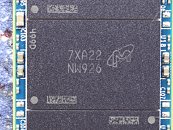Thursday, August 16th 2018
NAND Flash Prices Could Reach $0.08/GB in 2019
Prices of NAND flash could drop to historic lows of $0.08 per gigabyte in 2019, according to Jim Handy from Objective Analysis, addressing delegates at the 2018 Flash Memory Summit. If you add the cost of the controller, optional DRAM chip, and other low-cost parts that make up an SSD, 480~512 GB drives under $70 could finally be a reality; followed by 1 TB under $120, and 2 TB under $200. Handy attributes the low prices to a catastrophic oversupply of NAND flash in the industry, which could push manufacturers to the brink of economic collapse.
The price drop is also accelerated with the introduction of the QLC (4 bits per cell) technology, which increases densities (and conversely decreases price/GB). Luckily, most NAND flash manufacturers also happen to make DRAM, and are offsetting some of their NAND flash losses with DRAM profits, as DRAM remains in undersupply. The NAND flash price-crash threatens to wipe out conventional hard-disk drives from the consumer-space, at least in matured markets; relegating them to developing markets.
Source:
The Register
The price drop is also accelerated with the introduction of the QLC (4 bits per cell) technology, which increases densities (and conversely decreases price/GB). Luckily, most NAND flash manufacturers also happen to make DRAM, and are offsetting some of their NAND flash losses with DRAM profits, as DRAM remains in undersupply. The NAND flash price-crash threatens to wipe out conventional hard-disk drives from the consumer-space, at least in matured markets; relegating them to developing markets.

14 Comments on NAND Flash Prices Could Reach $0.08/GB in 2019
100MBps speed when cache is full is seriously not what i would expect.
As far as i understand, the free space of the drive is used as a SLC cache.
The more full drive is, the less cache it has. Futhermore, it will reorganize data after being written into this cache, so that all the bytes are moved to fill the TLC/QLC cells and releases other SLC cells.
This reorganization works at 100MBps max speed.
This means, that if you copy a 1GB file to a drive, it will first fill 1GB worth of SLC cells in 1 second (lets say write speed is 1GBps), then it will take about 9 more seconds to move that data from 1 billion SLC cells into 250 million QLC cells. So the whole operation takes 10 seconds and during this time, drive is in active mode while consuming more energy.
If you take samsung pro nvme, which is MLC, you will see that the speed is constant no matter how much data is on the drive and how much is copied. This means that at speed of 1GBps the whole operation will take 1 second to complete without additional housekeeping required. It will return to idle state much sooner consuming much less power per operation.
correct my if am wrong.
nand flash price drop's
dram prices soon reach the sky :/ someone should die
If the algorithm is designed correctly to deal with this, it's a non issue for consumer workloads.
I'd be more concerned with data retention, since QLC is higher density and cheaper hence can be used as a storage medium.
All TLC and now QLC drives run a portion of their NAND in SLC mode precisely for caching, since SLC is fastest. The more free space the drive has, the larger the cache can be.
When you copy a file to such a drive, it gets put into the SLC cache. Then, over time - as the drive does its normal housekeeping* - the cache is flushed and that file gets migrated bit-by-bit to the ordinary NAND. This process is completely transparent to the end-user, and once the file is fully moved, it's removed from the cache and the pointer moved to the ordinary NAND.
But if the SLC cache is too small (because the drive is near full), or already full, the written file has to go directly to the underlying NAND, and that will be slow for TLC and even slower for QLC. That is generally the only time that drive speed will drop to unacceptable levels. If you follow the advice from the first days of SSDs - never fill the drive, or always keep enough free space to contain all the files you think you will copy - you will never have a problem.
tl;dr unless your SSD is nearly full and you are copying large files to it, you will never notice the lower performance of TLC or QLC or whatever comes after them. For normal consumer workloads, a TLC/QLC drive will behave like an SLC drive.
* Yes, the housekeeping takes time and the drive is busy during that time, but we're talking a couple of watts of power here at worst. The high-performance NVMe controllers from Samsung are older and far less efficient at managing power than the new generation of controllers designed for TLC and QLC, so on balance I'd expect a TLC/QLC drive to be more efficient overall despite being more active.
Relax, price will decrease but very very slowly...
At least the Party it's the Cartel controlling the prices :laugh::laugh::roll: